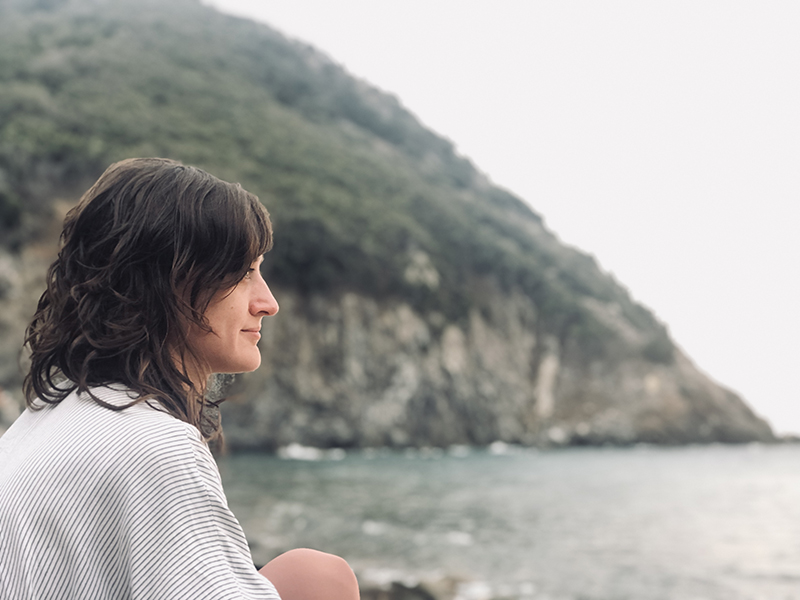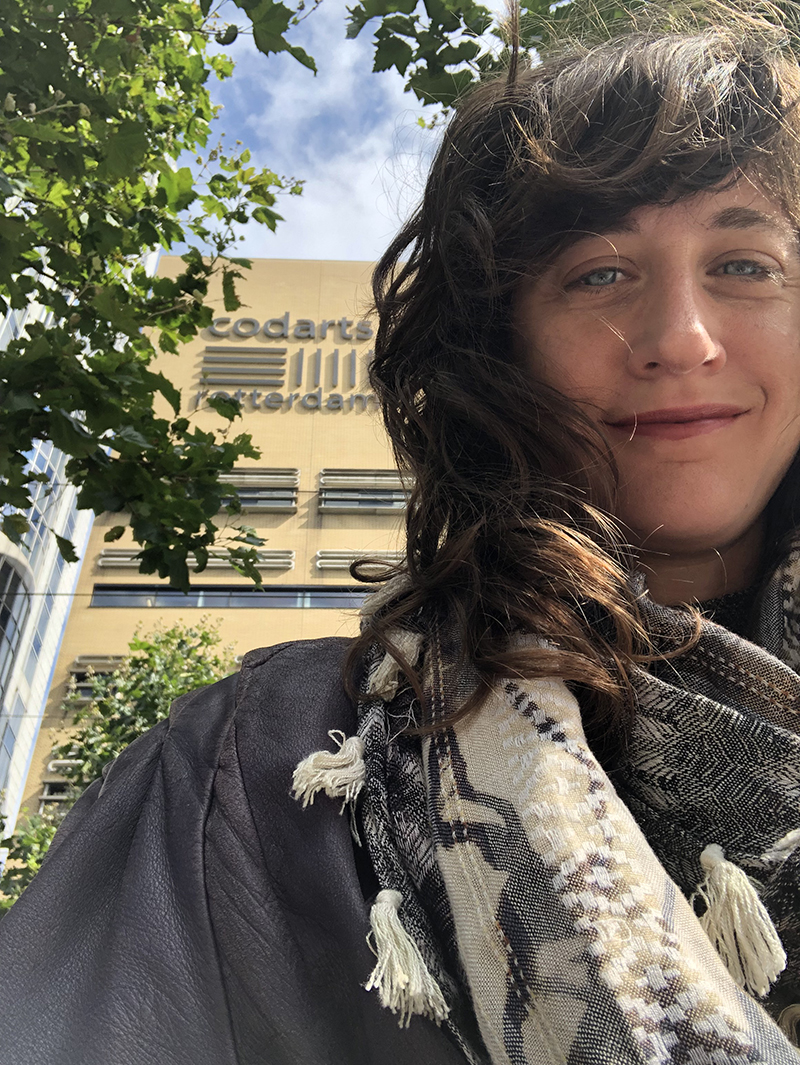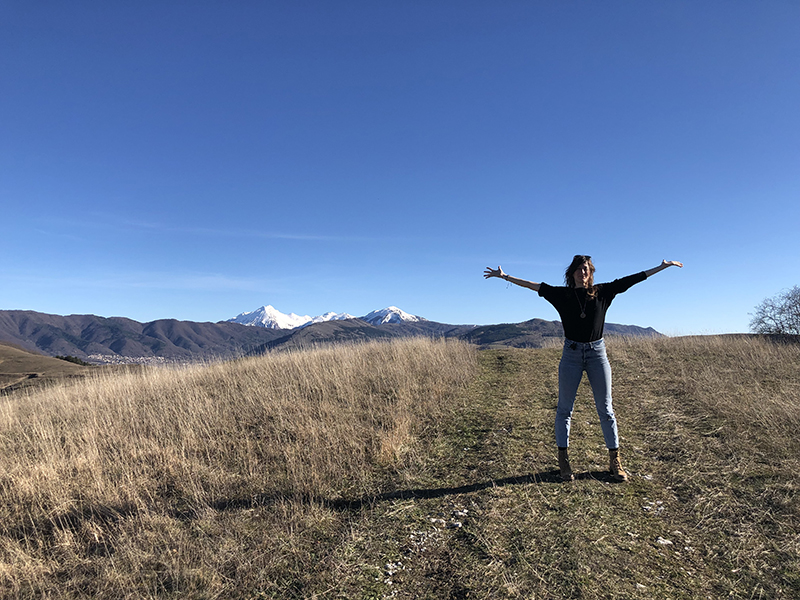“Focus on pleasure. Freedom. You have permission. No Expectations.”
BY SOPHIA DIEHL
Note: This essay was first published in Stance on Dance’s spring/summer 2022 print issue. To learn more, visit stanceondance.com/print-publication.
These are the loving reminders you will hear over and over again from Giulia Carotenuto, a Dance Movement Therapist, as she facilitates her weekly class at Gibney Dance Center. Giulia’s Saturday morning class is a new addition to Gibney’s schedule and one that is becoming a staple for professional dancers in New York City, alongside their rigorous routines of rehearsals and auditions. It offers a much-needed opportunity to reflect and, as Giulia would say, to engage with dancing as a full, creative human being.
Giulia begins each class with the same playful ritual. After taking a moment to gather the group, she kindly asks the dancers to leave the room. We all do, some with a knowing familiarity and others with a perplexed curiosity. Giulia closes the door behind us and then opens it again to invite us into the studio. This time, she encourages us to enter with intentional presence, taking in the space as if it is a friend we are meeting for the first time. As our eyes wander over unnoticed details of the floor’s texture or the pattern of natural light on the ceiling, she invites us to become aware of our bodily sense of comfort or discomfort. How do we feel in this space? Where in this studio do we experience a bodily sense of ease? Once we identify a place of ease, Giulia invites us to claim that spot as a safe space and to rest there. “You can always return to this space,” she tells us. “It is yours.”
The rest of class unfolds with dynamic explorations of the tools and techniques of Dance Movement Therapy. We engage in Bartenieff Fundamentals, Laban Movement Analysis, Authentic Movement, stream of consciousness writing, and visual art, all with the intention of uncovering the innate wisdom of our bodies. This weekly class is a cornerstone of the cultural transformation Giulia is ushering into the New York City professional dance field…the reclaiming of embodiment.

Photo by John Mosloskie
What is embodiment? Giulia defines it as the body, mind, emotion continuum and our relationship to these three realms of experience. At any given moment, we can ask ourselves, “What am I sensing (body)? What am I thinking (mind)? What am I feeling (emotions)?” If we are embodied, we experience an integration between our thoughts, emotions, and physical sensations and are able to care for ourselves, safely connect with others, and make meaning of our experiences.
As dancers, we spend much of our lives refining the body as an instrument of expression. But Giulia clarifies that being in the body does not equate to being embodied. The physical, psychological, emotional, and financial stressors of professional dance training often trigger disassociation, or a detachment from the present moment and our authentic experience of it.
“If we fully listened to what we are feeling and experiencing in the moment, most of us would not be able to sustain the demands of a professional dance career.” -Giulia Carotenuto
Giulia experienced this disassociation as a young dancer growing up in Italy. While drawn to ballet for its grace and elegance, her formative years are saturated with memories of self-criticism and daunting expectations from authority. She recalls a physical assessment, in which she and other aspiring dancers were analyzed solely on their anatomical potential, such as flexibility and external rotation of the hips. These early experiences contributed to self-objectification, a feeling that many dancers can resonate with amidst the constant pursuit of approval.
Giulia later moved to California to pursue a BFA in Dance and eventually to New York City, where she entered the professional field. The emotional challenges of auditioning and working within settings that were often harmful and sometimes bordering on abusive reinforced the detriment of her early dance training. Giulia was drawn to experimental performance work that directly engaged audiences and pushed the limits of artistic expression. She was filled by the empathy and connection that this type of work created with audience members. However, she also felt that her full humanity was not always being considered, seen, or heard by some of the demands placed on her to push herself beyond her own boundaries of safety in service of the work.
The accumulated stress of training and professional life contributed to Giulia’s decision to step away from performance and return home to Italy. During her time there, an acquaintance introduced her to the field of Dance Movement Therapy. Inspired by the possibilities of healing through dance, Giulia left home again, this time to pursue a master’s degree in Dance Movement Therapy at Codarts University in Rotterdam (the Netherlands). Her years in the program were rich with opportunities for healing her own pain and learning to guide others through theirs. “Dance was originally born as a healing practice,” Giulia recognizes, and it can continue to function as one. She discovered a personal mission to help other artists reconnect with dance as an avenue for healing rather than self-abuse.

Photo by by Giulia Carotenuto in front of Codarts
The trauma incurred by the dance field is especially poignant for those who have been marginalized by Euro-centric training and aesthetics. Giulia articulates that the studio can become yet another space of non-belonging for dancers of color, disabled dancers, and larger-bodied dancers, leading to self-alienation. This rupture is particularly heartbreaking in light of the fact that most dancers first saw their practice as a relationship with pleasure and joy.
Giulia speculates that the seeds of healing might be found in remembering these origin stories of dance, which are often coated in joy and connection. There is then a need for examining the beliefs and educational experiences that tainted these early motivations. Giulia cultivates an environment within her classes that offers validation for personal choice-making, provides freedom for risk-taking, and affirms the inherent value of each mover. She asks dancers to return to one essential question: “How does this feel?” rather than “How does it look?” Giulia hopes to see Dance Movement Therapy integrated into the curricula of college programs and exhorts choreographers to honor the boundaries of their performers when stepping into the territory of emotional risk-taking.
The need for healing in the dance field has been exacerbated by the impact of the past two years on physical, emotional, and psychological health. When I asked Giulia to speak to the bodily effects of the pandemic, she opted for a physical gesture instead, caving her shoulders in towards her chest and covering her face with her hands. “For the past two years, we have lived with a chronic sense of danger and fear,” she explains. When our bodies are faced with a threat such as COVID-19, they respond accordingly through adaptive reactions which become stuck in our physicality as maladaptive responses. As we begin to process the trauma of this pandemic, Giulia invites us into the practice of softening.
Dancers have experienced this softening on a visceral level in Giulia’s classes. One attendee is an international student who recently moved to the states to study dance. In an early class, Giulia invited the dancers to begin in a fetal position with hands clenched and arms crossed over the chest. The student shared that this position evoked a feeling of fear and inability to engage beyond herself. After months of attending Dance Movement Therapy classes, she explains, “Now, I feel safety and comfort in that position, as well as an ability to reach beyond myself and engage with the world.” By exploring her personal sense of embodiment, she has untangled her anxieties and feels more confident in her own presence.
Through the practice of embodiment, dancers can create from a place of joy and access a space within themselves that feels inherently worthy and untainted by the perceptions of others. As Giulia says at the beginning of class, “You can always return to this space. It is yours.”

Photo by John Mosloskie
~~
To learn more about Giulia Carotenuto and her Dance Movement Therapy practice, please visit www.giuliacarotenuto.com and www.healingdanceandmovement.com. You can register for her drop-in class at Gibney Dance Center at https://gibneydance.org/class-schedule/.
Sophia Diehl lives in New York City and enjoys a career as a dance artist through performance, choreography, and education. After graduating from St. Olaf College with a BA in Dance and Religion, she began working with Stuart Pimsler Dance & Theater, a company with a focus on arts in health. She has enjoyed working with community populations, from cancer survivors to veterans, as they give creative expression to their stories. Her choreographic work combines personal narrative with somatic research to produce soulful explorations of human experience.
This essay was first printed in Stance on Dance’s spring/summer 2022 print issue. To learn more, visit stanceondance.com/print-publication.
